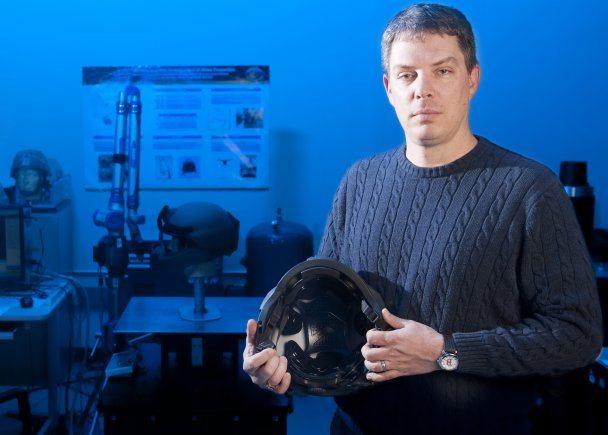Whether someone absorbs a hit by an improvised explosive device or a charging linebacker, the effect can be devastating on the human brain.
Knowing that, researchers from the Natick Soldier Research, Development and Engineering Center are examining technology developed at the University of Southern Mississippi for football helmets that could one day also help protect Soldiers.
A liner system designed at the Southern Mississippi polymer science laboratory, with assistance from the school’s sports medicine department, has been used in the Neuro Responsive Gear, or NRG, helmet produced by Rawlings Sporting Goods. The NRG features a system that combines foam and air bladders to more effectively absorb impacts. The helmet is being used in the National Football League and in the college ranks.
Don Lee, a project engineer in the Headgear Thrust Area of NSRDEC, is now looking at how that technology could apply to military helmets.
“I was approached by the University of Southern Mississippi early last summer,” Lee said. “They had gotten wind that we were doing helmet work, and they had been doing a lot of work with Rawlings on a pneumatic liner system for football helmets, mainly.
“They ended up coming up here and bringing one of their prototype liner systems, and we went over to the helmet lab here at the base and we tested the helmet. It actually showed some good preliminary data for an un-optimized system.”
Lee works to prevent traumatic brain injuries, or TBIs. He understands that once damaged, the brain can’t repair itself and the injury is permanent. He sees potential in the University of Southern Mississippi system.
As Lee has pointed out, Soldiers and athletes are equally vulnerable to TBI. Increasingly, the military, academia and the sports industry are sharing information on the subject.
“We’re all tied in together, supporting each other,” Lee said. “It’s not like we’re all working inside a vacuum. Right now, the commonality is protecting the head, and that’s what’s tying everything together.
“There’s a lot of talk of crossover (in) protecting Soldiers, protecting players. I think that’s what led Southern Mississippi to us. That’s the commonality, is the (mild traumatic brain injury). I just think it’s going to be an issue that’s going to be going on for a long time.”
Lee visited University of Southern Mississippi’s polymers lab and sports medicine department and came away impressed with the work they are doing together, and with Rawlings.
“What they had initially showed in the data they provided showed that there was promise for an improved liner protection,” said Lee, “and I didn’t want to let the opportunity pass me by.”
Because the University of Southern Mississippi liner system uses different air-filled chambers, it has possible advantages that other pneumatic systems lacked.
“If you put a large weight in your helmet like a night-vision device, all the air would be pushed out of that bag into bags in the back,” said Lee of the old systems, “and then you’d have a stability issue when you actually have the helmet sliding down your face.”
Leveraging different polymers, chambering and their relationship with Rawlings, the University of Southern Mississippi “actually produced a liner that received a five-star safety rating for football helmets. It just shows that we’re all fighting the same fight — trying to mitigate brain injury.”
Lee said he’s reluctant to ignore any system that shows potential for helping Soldiers.
“You get people (saying), ‘Why are you looking at all this stuff?'” Lee said. “It’s turning over all the rocks and leaving no stone unturned.”










